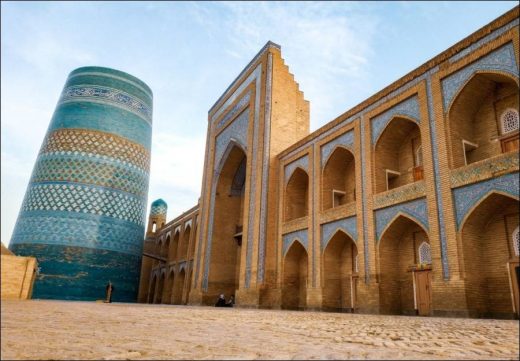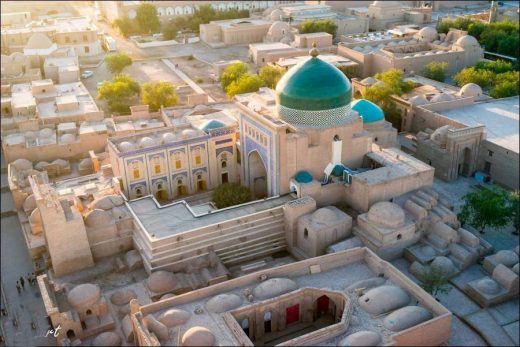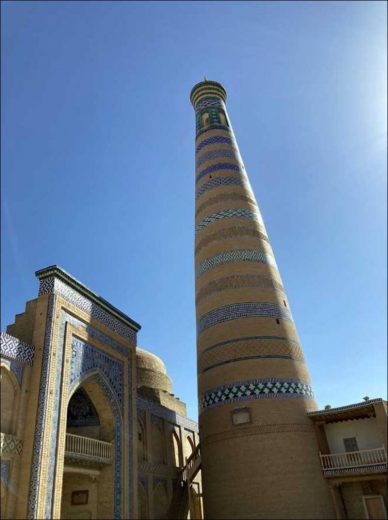In my youth, I dreamed of seeing several cities and places in distant lands one day: For example, Lhasa, the capital of Tibet, and Potala, the palace of the Dalai Lama, the spiritual leader of the Buddhists, in Samarkand of Uzbekistan, which was a Soviet Republic until 1991. city, especially Timur’s tomb “Gur-ı Emir” in Samarkand and finally two dream cities in Uzbekistan: Bukhara and Khiva.
In the 1970s and 1980s, it was almost impossible to go to these cities. Tibet was now a province of China and they did not accept tourists, the same was the case for Uzbekistan. Then years passed, the world changed and it was possible to see both the Dalai Lama’s and Timur’s hometown. There was one city left, Khiva, which is also in Uzbekistan, and I was able to see and tour Khiva this week.
The history of Khiva, which is located in the Khwarezm region of Central Asia and was the capital of Khwarezm for centuries along with Ürgenç, dates back to 15 centuries ago, but it gained its real place in history when it was the capital of the Khiva Khanate, which was founded in the early 1600s.
A history full of challenge and blood
Now, let me briefly talk about the history of the Khiva: After the death of Timur, who was the founder of the largest state in Asia after the Genghis Empire, in 1405, throne struggles broke out in the empire he left…
The four branches of the steppe people, called the “Cuci Nation”, constituting the people of Cuci, the eldest son of Genghis Khan, later began to use the name of Uzbek Khan, one of Cuci’s successors, namely the word “Uzbek” to introduce themselves. Thus, the emerging Uzbek Nation became an independent group after Ebulhayr was declared khan in 1428 and gradually began to seize the lands under the rule of Timurids.
After Ebulhayr’s grandson Shaybanî Khan took Samarkand in 1500 and Herat in 1507, the Timurid Empire came to an end and two states emerged in Turkestan in the following years: Bukhara Emirate and Khiva Khanate. After these states, another khanate, the Fergana Khanate, was established in Kokand in 1710, and thus three separate states began to rule in Turkestan.
However, the histories of these states, which were established in the lands of Central Asia where once a very bright civilization existed, were full of conflicts and their fates resulted in disasters.
The Uzbeks and the Turkmens tried to destroy each other, the dynastic fights and the struggles between the tribes never came to an end, and the Central Asian Khanates struggled both among themselves and with the Russians in this way for centuries. Russia has always been involved in dynastic and tribal quarrels, and has always benefited from the hostility of the Turkish states to each other.
While the rival wing of a dynasty approached the Russians and asked for the support of the Tsar to fight the other side, rival tribes also asked for help, but the conditions suddenly changed, this time they would go to war with the Russians and the khanates would be defeated in almost all of these wars, with one or two exceptions. .
As a result, the Khanate of Kokand in 1876; The Emirate of Bukhara and the Khanate of Khiva also came under Soviet rule in 1920. The Khiva state, which was occupied by the Russians in 1873, was able to continue its existence for a while, but after the reformists cooperated with the Russians to overthrow the ruler, Khiva became the “People’s Republic of Khwarezm” on April 26, 1920, and its lands were in Uzbekistan, Karakalpakstan, Turkmenistan and Khwarezm four years later. was divided among them and nothing remained of the “Khwarizm” or “Khiva” State!
Masterpieces of tile and woodworking
Khiva, which was one of the leading scientific centers of Central Asian Islam together with Bukhara, until the Soviet occupation, is today a city of Uzbekistan’s Urgench Province…
We took minibuses to Khiva, thirty kilometers away from Ürgench, after an hour and twenty-minute flight from Tashkent. We entered the city through the doors resembling a movie set on the walls, which were built centuries ago and still stand intact, and toured Khiva with President Tayyip Erdoğan, host Uzbekistan’s President Şevket Mirziyoyev, his wives and the official delegation of the President who attended the visit to Uzbekistan.
Hive, where there were ninety-odd mosques and more than sixty madrasas until the Soviet Revolution in 1917, was a dream-like city in the middle of the desert with its Kalta Minar covered with masterpieces of tile art, other minarets covered with tiles, madrasas and mosques with huge iwans in front of them.
Since I do not want to turn the article into a travel diary, I will talk about Hive this much. From the photos I have published, you will already see what kind of place the city is…
Let me just say this: You can always travel to Europe, America and other parts of the world, but if you have the opportunity to visit other countries, do not neglect to visit the mysterious cities of Central Asia such as Samarkand, Bukhara and Khiva. These places are both our past and a world apart from each other.
Visits: 85





